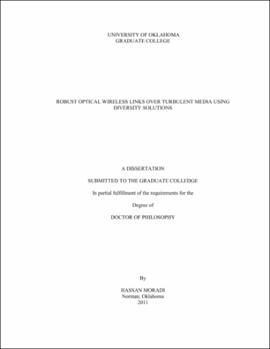| dc.contributor.advisor | Refai, Hazem H. | |
| dc.creator | Moradi, Hassan | |
| dc.date.accessioned | 2019-04-27T21:31:23Z | |
| dc.date.available | 2019-04-27T21:31:23Z | |
| dc.date.issued | 2011 | |
| dc.identifier | 9926801802042 | |
| dc.identifier.uri | https://hdl.handle.net/11244/318906 | |
| dc.description.abstract | Free-space optic (FSO) technology, i.e., optical wireless communication (OWC), is widely recognized as superior to radio frequency (RF) in many aspects. Visible and invisible optical wireless links solve first/last mile connectivity problems and provide secure, jam-free communication. FSO is license-free and delivers high-speed data rates in the order of Gigabits. Its advantages have fostered significant research efforts aimed at utilizing optical wireless communication, e.g. visible light communication (VLC), for high-speed, secure, indoor communication under the IEEE 802.15.7 standard. However, conventional optical wireless links demand precise optical alignment and suffer from atmospheric turbulence. When compared with RF, they suffer a low degree of reliability and lack robustness. Pointing errors cause optical transceiver misalignment, adversely affecting system reliability. Furthermore, atmospheric turbulence causes irradiance fluctuations and beam broadening of transmitted light. Innovative solutions to overcome limitations on the exploitation of high-speed optical wireless links are greatly needed. | |
| dc.description.abstract | Spatial diversity is known to improve RF wireless communication systems. Similar diversity approaches can be adapted for FSO systems to improve its reliability and robustness; however, careful diversity design is needed since FSO apertures typically remain unbalanced as a result of FSO system sensitivity to misalignment. Conventional diversity combining schemes require persistent aperture monitoring and repetitive switching, thus increasing FSO implementation complexities. Furthermore, current RF diversity combining schemes may not be optimized to address the issue of unbalanced FSO receiving apertures. | |
| dc.description.abstract | This dissertation investigates two efficient diversity combining schemes for multi-receiving FSO systems: switched diversity combining and generalized selection combining. Both can be exploited to reduce complexity and improve combining efficiency. Unlike maximum ratio combing, equal gain combining, and selective combining, switched diversity simplifies receiver design by avoiding unnecessary switching among receiving apertures. The most significant advantage of generalized combining is its ability to exclude apertures with low quality that could potentially affect the resultant output signal performance. | |
| dc.description.abstract | This dissertation also investigates mobile FSO by considering a multi-receiving system in which all receiving FSO apertures are circularly placed on a platform. System mobility and performance are analyzed. Performance results confirm improvements when using angular diversity and generalized selection combining. | |
| dc.description.abstract | The précis of this dissertation establishes the foundation of reliable FSO communications using efficient diversity-based solutions. Performance parameters are analyzed mathematically, and then evaluated using computer simulations. A testbed prototype is developed to facilitate the evaluation of optical wireless links via lab experiments. | |
| dc.format.extent | 181 pages | |
| dc.format.medium | application.pdf | |
| dc.language | en_US | |
| dc.relation.requires | Adobe Acrobat Reader | |
| dc.subject | Free space optical interconnects | |
| dc.subject | Optical communications | |
| dc.subject | Wireless communication systems | |
| dc.title | Robust Optical Wireless Links over Turbulent Media using Diversity Solutions | |
| dc.type | text | |
| dc.type | document | |
| dc.thesis.degree | Ph.D. | |
| ou.group | College of Engineering::School of Electrical and Computer Engineering | |
